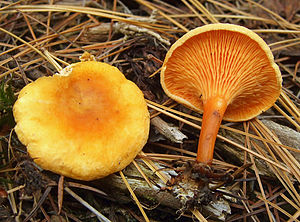Anal glutins
| Anal glutins | ||||||||||||
|---|---|---|---|---|---|---|---|---|---|---|---|---|

False chanterelle ( Hygrophoropsis aurantiaca ) |
||||||||||||
| Systematics | ||||||||||||
|
||||||||||||
| Scientific name | ||||||||||||
| Hygrophoropsis | ||||||||||||
| ( J. Schröt. ) Maire in Martin-Sans |
The hygrophoropsis ( Hygrophoropsis ) are a fungal genus of the order of Dickröhrlingsartigen (Boletales).
The type species is the false chanterelle ( H. aurantiaca ).
features
Macroscopic features
The 0.5–7 (–10) cm wide cap is initially arched, but soon spreads out to depressed or almost funnel-shaped. The edge is curled up young. The dry surface has a velvety to finely felted, more rarely also a fine-grained, flaky structure. The color spectrum ranges from whitish to light yellow, cream ocher and orange to pink and orange to tobacco brown. The closely spaced lamellae fork several times, sometimes appear somewhat veiny and run down the stem. They can be of the same color palette as the hat, to brick-red tones. In addition, they can be easily removed from the hat meat. The stem is sometimes a little eccentric. The fruit body consists of soft, juicy meat . The spore powder is white to pale cream ocher in color.
Microscopic features
The cystideless fruit layer consists of small basidia , on which 3.5–11 (–13) cm long, smooth-walled spores ripen without a germ pore - they have an almost spherical, oval, elliptical or cylindrical shape. They discolour wine-red ( dextrinoid ) with iodine solution . The cell walls can be stained purple with cotton blue (cyanophil). The mushroom threads have buckles on the transverse walls . The lamellar trama is set up regularly. The cap skin consists of radial, lying hyphae . In some species it is a trichoderm in the middle .
ecology
The Afterleistlingen are saprobionts on forest and meadow soils, more rarely they also grow directly on rotten tree stumps and wood waste such. B. Bark meal. They cause brown rot .
species
The following taxa are known or expected for Europe .
| Anal glutinous ( Hygrophoropsis ) in Europe |
White-leaved anal serration ( Hygrophoropsis aurantiaca f. Albida )
Large-spore anus epithelium ( Hygrophoropsis macrospora )
Brown-red pelvis ( Hygrophoropsis rufa )
Former species
The fragrant after glutinus ( Aphroditeola olida , formerly Hygrophoropsis morganii) is now listed in the independent genus Aphroditeola because it is related to the snail relatives in the mushroom-like order and, unlike the "real" after glutinus, has no dextrinoid spores.
meaning
As edible mushrooms, the after-leglets are not considered due to their inferior value or rare occurrence. The false chanterelle is sometimes eaten, but it can cause gastrointestinal discomfort in sensitive people.
swell
literature
- Ewald Gerhardt: FSVO manual mushrooms . 3. Edition. BLV, Munich 2002, ISBN 3-405-14737-9 , p. 337 (one-volume new edition of the BLV intensive guide mushrooms 1 and 2).
Individual evidence
- ↑ a b c Achim Bollmann, Andreas Gminder , Peter Reil: List of illustrations of large European mushrooms . In: Yearbook of the Black Forest mushroom teaching show . 4th edition. Volume 2. Schwarzwälder Pilzlehrschau, 2007, ISSN 0932-920X (301 p., Directory of the color images of almost all European large mushrooms (> 5 mm) incl. CD with over 600 species descriptions).
- ↑ Émile Martin-Sans: Hygrophoropsis . In: L'Empoisonnem. Champ . tape 99 , 1929.
- ↑ a b c d Erhard Ludwig: Descriptions. The smaller genera of macromycetes with a lamellar hymenophore from the orders Agaricales, Boletales and Polyporales . In: Mushroom Compendium . tape 1 . IHW, Eching 2001, ISBN 3-930167-43-3 (German with English summaries, 17 × 24 cm, contains 20 new taxa and 13 new combinations).
- ↑ a b c Andreas Gminder: Hygrophoropsis . In: Gminder, Andreas., Krieglsteiner, German J., Kaiser, Armin (eds.): Die Großpilze Baden-Württemberg . tape 3 . Ulmer, Stuttgart (Hohenheim) 2001, ISBN 3-8001-3536-1 , p. 273 .
- ↑ Eric Strittmatter: The genus Hygrophoropsis. (No longer available online.) In: Fungiworld.com. Mushroom Taxa Database. November 13, 2005, formerly in the original ; Retrieved March 25, 2012 . ( Page no longer available , search in web archives )
- ↑ Andreas Kunze: The False Chanterelle and other Afterleistlinge in Europe . In: The Tintling . tape 77 (4) . Karin Monday, 2012, ISSN 1430-595X , p. 86–99 ( table of contents available online ).
- ↑ Holec J., Kolařík M .: Notes on the identity of Hygrophoropsis rufa (Basidiomycota, Boletales). In: Czech Mycol. 65 (1): 15-24. June 2013, accessed May 10, 2020 .
- ^ Scott A. Redhead, Manfred Binder: Nomenclatural novelties . In: Index Fungorum . tape 15 , 2013 ( indexfungorum.org [PDF; 82 kB ]).
Web links
- Frank Moser: False Chanterelle (Hygrophoropsis aurantiaca). In: Natur-Lexikon.com. Retrieved March 25, 2012 .
- "Le Schtroumpf mycologue": Hygrophoropsis aurantiaca f. albida / Clitocybe orange, form blanche. In: Flickr.com. November 2, 2010, accessed March 25, 2012 .
- Malcolm Storey: Hygrophoropsis fuscosquamula PD Orton, 1960 (a false chanterelle). In: BioImages: The Virtual Field Guide (UK). Retrieved March 25, 2012 .


